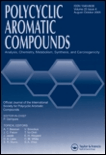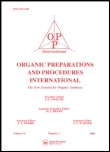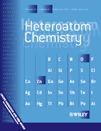
POLYCYCLIC AROMATIC COMPOUNDS
Scope & Guideline
Leading the Charge in Polycyclic Aromatic Studies
Introduction
Aims and Scopes
- Synthesis of Polycyclic Aromatic Compounds:
The journal highlights research on various synthetic methods for creating polycyclic aromatic compounds, with a focus on novel and efficient techniques including one-pot reactions and green chemistry approaches. - Environmental Impact Studies:
A significant portion of the research is dedicated to the environmental implications of polycyclic aromatic hydrocarbons (PAHs), including their presence in various ecosystems and potential health risks associated with exposure. - Biological Activity and Pharmacological Applications:
Research articles often explore the biological activities of synthesized compounds, including antimicrobial, anticancer, and anti-inflammatory properties, showcasing the therapeutic potential of these compounds. - Computational and Theoretical Studies:
The journal includes studies employing computational chemistry methods such as DFT and molecular docking to predict the behavior and interactions of PACs, aiding in the rational design of new compounds. - Multicomponent and Sustainable Synthesis:
There is a strong emphasis on developing multicomponent synthesis strategies that are efficient and environmentally friendly, often utilizing biocatalysts or recyclable nanocatalysts in reactions.
Trending and Emerging
- Green and Sustainable Chemistry:
There is a marked increase in research focused on environmentally friendly synthesis techniques, including the use of biocatalysts, natural solvents, and waste materials to reduce environmental impact. - Nanocatalyst Development:
The use of nanotechnology in catalysis is trending, with studies showcasing the efficiency of magnetic and recyclable nanocatalysts in the synthesis of PACs and related compounds. - Multicomponent Reactions:
Research on multicomponent synthesis strategies is gaining popularity, highlighting their efficiency and the ability to create complex structures in a single step. - Environmental Remediation Technologies:
Emerging studies are focusing on innovative technologies for the remediation of PAHs in contaminated environments, emphasizing bioremediation and advanced oxidation processes. - Computational Chemistry and Drug Design:
An increasing number of articles employ computational methods for drug design and molecular modeling, particularly for anticancer and antimicrobial applications of PACs.
Declining or Waning
- Traditional Synthesis Methods:
There is a noticeable decline in articles focused on conventional synthesis methods for PACs, as newer, more efficient, and greener methodologies gain traction. - Basic Environmental Monitoring:
While environmental studies remain important, the journal has seen a reduction in basic monitoring studies of PAH concentrations without accompanying innovative solutions or remediation strategies. - Single-Component Reactions:
Research centered on single-component reactions is becoming less common, as the field moves towards more complex, multicomponent synthesis approaches that offer higher yields and reduced waste. - Focus on Historical Compounds:
There seems to be a waning interest in the historical analysis of well-known PACs, as contemporary research increasingly targets novel compounds and their unique properties. - Non-Green Chemistry Approaches:
Research that does not prioritize green chemistry principles is declining, indicating a shift towards sustainability and eco-friendliness in chemical research.
Similar Journals

INDIAN JOURNAL OF HETEROCYCLIC CHEMISTRY
Advancing Knowledge in Heterocyclic ChemistryINDIAN JOURNAL OF HETEROCYCLIC CHEMISTRY, published by CONNECT JOURNALS, is a vital resource in the fields of organic chemistry and biochemistry, aiming to advance research and promote innovation within the realm of heterocyclic compounds. Established in 1996, this journal has successfully converged into an influential publication with a commitment to disseminating high-quality, peer-reviewed research articles that enhance the understanding of heterocyclic chemistry applications. Although it currently holds a Q4 quartile ranking in both biochemistry and organic chemistry according to the 2023 categorizations, its broader contributions to the scientific community should not be underestimated, as it seeks to support the ongoing dialogue among researchers, professionals, and students. The journal operates from Ghaziabad, India, providing open access to its publications, thereby fostering a collaborative and informative environment for its international readership. With an ISSN of 0971-1627 and a special focus on contemporary challenges and developments in the field, the INDIAN JOURNAL OF HETEROCYCLIC CHEMISTRY is poised to make a significant impact as it continues to evolve through 2024 and beyond.

JOURNAL OF HETEROCYCLIC CHEMISTRY
Elevating Heterocyclic Research to New HeightsJournal of Heterocyclic Chemistry, published by Wiley, stands as a key resource in the field of organic chemistry, offering in-depth research articles and insights spanning from 1966 to 2024. With its strong Scopus ranking of #83 out of 211 in the Organic Chemistry category, placing it in the 60th percentile, the journal maintains its significance and relevance within the academic community. Although it does not currently offer open access options, it provides extensive coverage of heterocyclic compounds, which are vital to various applications in pharmaceuticals and material sciences. The journal's commitment to high-quality research is further reflected in its classification as Q3 in the 2023 quartiles for Organic Chemistry. Researchers, professionals, and students alike will find valuable contributions to the intricate studies of heterocycles, enhancing their understanding and exploration of this fascinating area of chemistry.

SYNTHESIS-STUTTGART
Pioneering Research in Catalysis and Synthesis Since 1970.SYNTHESIS-STUTTGART
Published by the esteemed Georg Thieme Verlag KG, SYNTHESIS-STUTTGART stands as a vital resource in the field of Chemistry, specifically focusing on Organic Chemistry and Catalysis. With an impressive publication history dating back to 1970 and continuing through 2024, it serves as a platform for innovative research and developments in synthetic methodologies and their applications. The journal holds a significant impact factor, reflecting its influence within the academic community, and is recognized in the Scopus rankings as a reputable source in its categories, with a rank of #99/211 in Organic Chemistry and #43/68 in Catalysis. Researchers, professionals, and students alike can benefit greatly from its content, which upholds rigorous peer-review standards and contributes to the global discourse in these critical scientific domains.

Results in Chemistry
Empowering Researchers with Open Access KnowledgeResults in Chemistry is a prominent journal published by Elsevier, dedicated to fostering innovation and disseminating cutting-edge research in the field of chemistry. With an ISSN of 2211-7156, this open-access journal has been committed to making scientific knowledge widely available since 2019, aligning with the global trend towards accessibility in research. Based in the Netherlands, it features interdisciplinary studies that span the breadth of general chemistry, contributing significantly to the academic dialogue within the scientific community. Despite currently holding a Q3 ranking in the miscellaneous category of chemistry and occupying the 228th position out of 408 in Scopus rankings, the journal is poised for growth, aiming to enhance its impact and visibility. Researchers, professionals, and students alike will find invaluable resources and insights within its pages, making Results in Chemistry an essential platform for those looking to stay abreast of advancements and trends in chemistry research up to the year 2024.

Nature Synthesis
Exploring Novel Pathways in ChemistryNature Synthesis, published by SpringerNature, is a premier peer-reviewed journal dedicated to advancing the field of synthesis in chemistry and materials science. With an impressive impact factor and categorized in the Q1 quartile for Chemistry (miscellaneous), Inorganic Chemistry, Materials Chemistry, and Organic Chemistry, it ranks prominently among its peers, reflecting its high-quality research output and relevance.
This journal provides a platform for researchers, professionals, and students to publish innovative synthesis methodologies, novel materials, and interdisciplinary approaches that push the boundaries of chemistry. Operating under an Open Access model, it ensures that research is widely accessible, fostering collaboration and engagement across the global scientific community.
Situated in the United Kingdom, Nature Synthesis is committed to contributing to the scientific discourse from 2022 to 2024, and beyond, as it continues to highlight significant advancements across chemistry domains.

ORGANIC PREPARATIONS AND PROCEDURES INTERNATIONAL
Empowering Researchers with Practical Organic ProceduresORGANIC PREPARATIONS AND PROCEDURES INTERNATIONAL is a prominent journal in the field of organic chemistry, published by Taylor & Francis Inc. With an ISSN of 0030-4948 and an E-ISSN of 1945-5453, this journal has been a vital resource for researchers since its inception in 1971, showcasing a broad range of methodologies, protocols, and innovative applications within organic synthesis. Although categorized in the Q4 quartile for organic chemistry, the journal provides a critical platform for researchers at all levels to disseminate their findings and to access a wealth of practical organic procedures. It currently ranks #151 out of 211 in the Scopus Organic Chemistry category, underscoring its role in advancing the discipline despite its relatively modest impact factor. The journal offers a diverse collection of scholarly articles that are essential for both professional chemists and students, enriching their understanding of organic preparation techniques. Inviting contributions that encompass the full spectrum of organic synthesis, this journal serves as a valuable conduit for knowledge exchange in the ever-evolving field of organic chemistry.

Heterocyclic Letters
Exploring the Frontiers of Heterocyclic ChemistryHeterocyclic Letters is an esteemed journal in the field of synthetic organic chemistry, published by RAMAN PUBL. With ISSN 2231-3087 and E-ISSN 2230-9632, this journal aims to disseminate original research and innovative findings related to heterocyclic compounds, which play a crucial role in medicinal chemistry, material science, and agricultural chemistry. Heterocyclic Letters provides a platform for researchers, professionals, and students to share their insights and advancements, thus fostering academic collaboration and knowledge transfer. The journal is dedicated to maintaining high-quality standards in research publication, making it an essential resource for anyone focused on the latest developments in heterocyclic chemistry. Although it does not currently offer Open Access options, the journal’s rigorous peer-review process ensures that only the most credible and impactful studies are published, contributing significantly to the advancement of the field.

Chemical Methodologies
Connecting Scholars to Transform Chemical KnowledgeWelcome to Chemical Methodologies, a premier journal published by SAMI PUBLISHING CO-SPC, dedicated to advancing the field of chemistry through innovative research and methodologies. With an ISSN of 2645-7776 and an E-ISSN of 2588-4344, this journal provides a vital platform for researchers and scholars to share their findings in areas encompassing physical, theoretical, and organic chemistry. Despite its initial HIndex and quartile rankings still being established, the journal's evolving impact within the academic landscape is underscored by its Scopus Ranks, which place it in the 35th percentile for physical and theoretical chemistry and the 33rd percentile for organic chemistry. Since its inception in 2022, and continuing through 2024, Chemical Methodologies aims to foster collaboration and knowledge dissemination among academics and practitioners alike, bridging theoretical concepts and practical applications. This open-access platform enhances accessibility for researchers and students worldwide, ensuring that groundbreaking contributions to chemical science reach a broad audience.

RUSSIAN CHEMICAL BULLETIN
Bridging Theory and Application in Chemistry.RUSSIAN CHEMICAL BULLETIN, published by SPRINGER, serves as a pivotal resource in the field of general chemistry, covering a wide array of topics that impact both theoretical and applied chemistry. With an ISSN of 1066-5285 and a presence since 1993, this journal provides a platform for disseminating significant research findings, practical applications, and novel methodologies within the broader chemistry community. While it currently holds a Q3 ranking in the Chemistry (miscellaneous) category and occupies the 230th position out of 408 in the Scopus rankings, its reputation continues to grow, fostering collaboration and innovation among researchers and professionals alike. Although the journal does not offer an open-access model, it is committed to making findings accessible within the academic community, ensuring that valuable insights can inform future research. With an anticipated convergence of studies extending to 2024, the RUSSIAN CHEMICAL BULLETIN remains an essential reference for those dedicated to advancing chemical science.

HETEROATOM CHEMISTRY
Pioneering New Frontiers in Heteroatom ResearchHeteroatom Chemistry is a prominent open-access journal dedicated to advancing the field of heteroatom chemistry, with a particular focus on the chemistry of elements other than carbon in organic compounds. Published by Wiley-Hindawi, this journal provides researchers, professionals, and students with a platform to disseminate and access novel research findings related to the synthesis, properties, and applications of heteroatom-containing compounds. Since its inception in 1990 and gaining open access status in 2019, the journal has fostered academic collaboration and innovation throughout its converged years, although it currently holds a category quartile ranking of Q4 in Chemistry (miscellaneous) and ranks #319 out of 408 in general chemistry within Scopus. With its commitment to high-quality research and broad accessibility, Heteroatom Chemistry is poised to be an essential resource for anyone looking to explore the rich and varied applications of heteroatom chemistry in diverse scientific fields.